TRANSITS AND OCCULTATIONS
RETURN TO PICTURE CATEGORIES
(Click pictures for largest version available)
 |
2006 TRANSIT OF MERCURY SIMULATION
Graphic Animation of the 2006 Transit of Mercury. Transits of Mercury across the face of the Sun are not extremely rare—13 to 14 per century. Fifty six have occurred since the beginning of the seventeenth century although a given transit may not be entirely or partially seen from one's locality. The last was 2006 November 8, the next 2016 May 9. This graphic animation simulates the crossing of Mercury in front of the Sun's disk during the last transit in 2006. Click animation for a larger version. The entire transit lasted about five hours. However, in Florida, for example, the Sun set before the transit was over so less than 3-1/2 hours of the transit was visible. (Animation by H.L. Cohen)
|
|
 |
2004 TRANSIT OF VENUS SIMULATION
Graphic Animation of the 2004 Transit of Venus. Transits of Venus across the face of the Sun are very rare—they occur in pairs separated by eight years but then the pairs occur less than once per century—every 105.5 or 121.5 years. Only eight have occurred since the invention of the telescope at the beginning of the seventeenth century. The last pair was in 2004 and 2012 and none will be seen again until the 21st century! The next is 2117 December 10 and, for example, will not be visible in Florida. This graphic animation simulates the crossing of Venus in front of the Sun's disk during the 2004 transit. Click animation for a larger version. The entire transit lasted just over six hours. However, in Florida, for example, the Sun rose while the transit was in progress so less than one hour of the transit was visible. (Animation by H.L. Cohen)
|
|
 |
2004 TRANSIT OF VENUS
Photograph of the 2004 Transit of Venus. The entire 2004 transit of Venus was visible from the Mediterranean region. This photograph was taken from the Greek Island of Crete, 2004 June 8 at 10:27 a.m. local time using a Tele Vue 101mm APO, f/5.35 refractor. Transits of Venus are far more noteworthy than those of Mercury not only because of their rarity and historical interest but also the much larger disk of Venus makes for a much greater spectacle. Until the 2004 transit of Venus, no one then alive had ever witnessed Venus crossing the Sun!
|
|
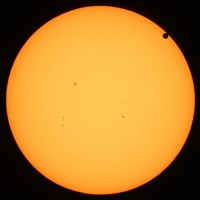 |
2012 TRANSIT OF VENUS NEAR SECOND CONTACT
Photograph of the 2012 Transit of Venus. This photograph of the 2012 transit was taken from Ft. Worth, Texas where about 30% of the 6h 44m transit was visible. Cloudy weather prevailed on days before and after the transit but skies were mostly clear on the day of the transit. This photograph was taken 2012 June 5 at 05:22:36 p.m. CDT close to second contact. Look closely and you can see the notorious "black drop effect" that appears to make Venus "stick" to the Sun's edge and makes timing this event difficult. (Click image to enlarge.) Most people alive today will never see a transit of Venus from Earth again since the next such event is more than a century away! Photo Details: Canon DSLR, EOS 5D Mark II; Canon EF, Tele Vue 76 mm, f/6.3 APO Refractor with Tele Vue 4x Powermate for effective f/25 focal ratio. Thousand Oaks Solar Filter (transmission 0.001%, optical density 5); Equiv. ISO 1600; 1/125 sec at Equiv. f/25, white balance at Auto.
|
|
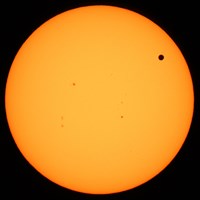 |
2012 TRANSIT OF VENUS
Photograph of the 2012 Transit of Venus. Similar to above photograph of the 2012 transit from Ft. Worth, Texas but taken 2012 June 5 at 06:18:05 p.m. CDT or about two hours later. Shortly after the Sun dipped below trees making further photography of the transit impossible. Photo Details: Canon DSLR, EOS 5D Mark II; Canon EF, Tele Vue 76 mm, f/6.3 APO Refractor with Tele Vue 4x Powermate for effective f/25 focal ratio. Thousand Oaks Solar Filter (transmission 0.001%, optical density 5); Equiv. ISO 1600; 1/125 sec at Equiv. f/25, white balance at Auto.
|
|
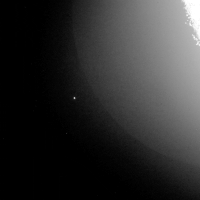 |
OCCULTATION OF BETA CAPRICORNI
Dark Limb Lunar Occultation of Beta Capricorni Over a hundred visitors came to the Alachua Astronomy Club's (AAC) International Observe the Moon Night (InOMN) at their Newberry Star Park, Saturday Night, 2013 Oct. 12 (above picture). Many were also thrilled to see the occultation of the third magnitude star, Beta Capricorni on a 40 in. LCD TV produced with a 127 mm refractor and a DSLR camera. Click image to see larger videos of occultation and more details. Bright limb of Moon is overexposed to reveal the dark limb where the occultation took place. Photo Date: 2013 October 12, abt. 9:21 p.m. EDT, Location: Newberry Star Park, Easton Newberry Sports Complex, Newberry, Florida. Photo Details: Tele Vue NP 127mm APO, f/5.2 with Tele Vue 4x Powermate giving effective f/21. Canon EOS 5D Mark II. Seven exposures (0.7 sec. each) used to make the short video. ISO equiv. 1600.
|
|
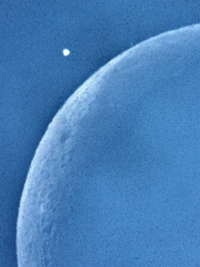
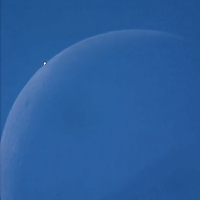
|
OCCULTATION OF VENUS
Daytime Occultation of Venus by Waning Crescent Moon A spectacular daytime occultation of Venus was observed over North Central Florida. Photo shows waxing gibbous Venus (17 arc sec disk, 69% illuminated) about seven minutes before its disappearance behind the bright but pale waxing lunar crescent (abt. 4 days before new phase, 13% illuminated).
Occultation was captured using a Canon DSLR in movie mode. A VIDEO (see links below) clearly shows both the planet's disappearance behind the lunar bright limb and its reappearance from behind the dark lunar limb about one and one-half hours later.
Bottom picture made from one of the movie frames shows Venus moving behind Moon.
Photo Date: 2015 December 7, 12:35 p.m. EST, Location: Gainesville, Florida. Photo Details: Tele Vue NP 127mm APO, f/5.2 with Tele Vue 4x Powermate giving effective f/21. Canon EOS 5D Mark II. Photo: 1/125 sec. ISO equiv. 400.
OCCULTATION VIDEOS:
mov video •
avi video •
mp4 video
or on YouTube (Length 3m22s)
(Videos open in new windows and may take a few moments to load . . .)
More occultation info in article: Daytime Occultation of Venus by Crescent Moon
|
|
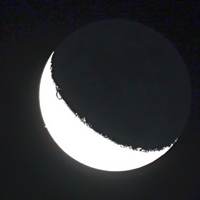
See Also GIF Animation
(Opens in new window)
|
OCCULTATION OF ALDEBARAN – 2016 JULY
A Bright Limb Occultation of Aldebaran (mag. abt. +0.9) by Waning Crescent Moon occurred early Friday morning, 2016 July 29. Aldebaran was difficult to spot near the bright limb of the 23% illuminated Moon without optical aid. However, one could easily see this bright star in binoculars. See photo on left showing Aldebaran next to the Moon's bright limb. (Click to enlarge.) Also see the attached short animation of the occultation that compresses 2m40 time into a 15-second movie clip. (Movie made from 14 individual photos taken with a 400-mm focal length camera lens with each frame trimmed down from its original size.) Moon is overexposed to bring out the fainter image of Aldebaran. Photo Date: 2016 July 29, 05:38 a.m. EDT (09:38 UT). Location: Gainesville, Florida. Photo Details: Fixed Mount. Canon DSLR, EOS 5D Mark II with Canon EF 100-400 at 400 mm. Exposure: f/5.6, 1/10 sec, ISO 3200. (Images trimmed from originals.)
Also see article about this occultation, See a Star Disappear (PDF). Opens in new window.
|
|
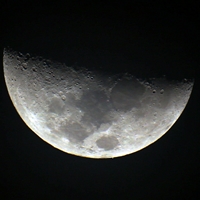
Reappearance Photo
(Click to enlarge in new window)
|
OCCULTATION OF ALDEBARAN – 2017 MARCH
A Dark and Bright Limb Occultation of Aldebaran (mag. abt. +0.9) by the First Quarter Moon occurred late Saturday evening, 2017 March 4. This was the best occultation of this first magnitude star in 2017. Unfortunately weather did not cooperate and passing clouds threatened seeing the occultation in my area. Hence, I had mixed success with this event but did put together a short movie presentation about my efforts ("An Occultation of Aldebaran?: An Occultation Story"). See mp4 link below.
Photo Date: 2017 March 4. Predicted Dark Limb Disappearance at 10:59:53 p.m. EST (March 5, 03:59:53 UT); Predicted Bright Limb Reappearance at 11:58:07 p.m. EST (March 5, 04:58:07 UT). Location: Gainesville, Florida. Photo Details: Tel Vue 76, f/6.3 APO Refractor with Tele Vue 4x Powermate; iOptron iEQ30 Equatorial Mount. Canon DSLR, EOS 5D Mark II Exposure: 1/30 sec at f/25. ISO 1600.
MP4 MOVIE (Running Time 9 min.): Large File – Give it time to load.
(Note: Video has audio track—make sure speakers on with volume up.)
|
|
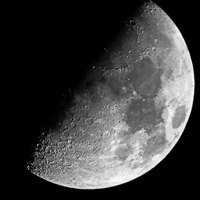
Egress (Click to enlarge)
See YouTube for Entire Show
|
NEAR GRAZING OCCULTATION OF ANTARES – 2023 AUGUST
A Dark and Bright Limb Occultation of Antares (mag. abt. +0.9 var.) by a near First Quarter Moon (age 8.7 days, illumination 58%). Occurred late Thursday
evening, 2023 August 24 from 11:17 to 11:28 p.m. EDT. (Add 4h for UT.) Occultation lasted only about eleven minutes. Disappearance quick but reappearance slow as Antares moved along lunar limb. Occultation a near graze with southern limit about 30 miles south of Gainesville, Florida. Mount proved unstable for setup so video somewhat shaky but occultation easily visible.
Photo from movie frame shows egress (lower left). See YouTube video for entire occultation. Video summarizes the near grazing occultation of Antares by the Moon as seen from Gainesville. Includes basic information about Antares, a simulation of the occultation and actual video of the occultation.
Photo Date: 2023 Aug. 24. Location: Gainesville, Florida. Photo Details: Tel Vue 76, f/6.3 APO Refractor with Tele Vue 4x Powermate; SkyWatcher Azimuth Mount. Canon DSLR, EOS 5D Mark II Exposure: 1/30 sec at f/25. ISO 3200.
|
|
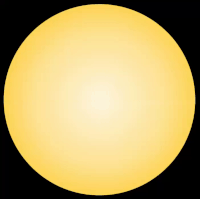 |
2016 TRANSIT OF MERCURY SIMULATION
Graphic Animation of the 2016 Transit of Mercury. Transits of Mercury across the face of the Sun are more common than those of Venus occurring about 13–14 times per century. However. they are not visible from all locations or may only be partially visible as was the case for Florida in 2009 when the Sun set before the transit was over. Nevertheless, the 2016 transit of Mercury was entirely visible over its 7.5 hour duration from Florida as will be the 2019 transit. Then none will be seen in Florida until 2049. This graphic animation simulates the crossing of Mercury in front of the Sun's disk during the 2016 transit. Click animation for a larger version. See photos below of the actual 2016 transit. Note: North is approx. to left, east down as it was a beginning of transit. (Animation by H.L. Cohen)
|
|

|
2016 TRANSIT OF MERCURY
Photograph of the 2016 Transit of Mercury. Transits of Mercury occur more often than transits of Venus (13-14 per century) but are interesting and historically significant. Unlike the previous transit of Mercury (2009) when the transit ended after sunset, the 2016 May 9 transit was visible during its entire 7.5 hour transit. However, the low altitude of the Sun at the beginning hid first contact for many observers. Although the disk of Mercury is small, its round, black shape (lower left) is easily distinguished from sunspots (center upper right). Photo taken when transit about 94% complete or about 23 minutes before last contact. Also see photo below near third contact. Photo Date: 2016 May 9, 2:18 p.m. EDT (UT 18:18). Location: Gainesville, Florida. Photo Details: Tele Vue NP 76mm APO, f/6.3 with Tele Vue 4x Powermate ,giving effective f/25. Canon EOS 5D Mark II. Thousand Oaks Solar Filter (transmission 0.001%, optical density 5). Exposure: 1/180 sec. ISO equiv. 1000. (North is approx. to right, east up as was near end of transit.)
|
SMALL ANIMATION (200x200)
LARGE ANIMATION (1200x1200)
|
Animations of Approximately Last 35 Minutes of Transit. (Time intervals through last contacts are shorter.) Also see next pictures (below) for photos at third contact including magnified view and animation (open in new windows).
|
|

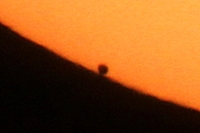 |
2016 TRANSIT OF MERCURY — BLACK DROP EFFECT
Photograph of the 2016 Transit of Mercury Near Third Contact. Mercury is about to leave the Sun's disk (about 7 o'clock position). Click pictures to enlarge for better view. Mercury's small disk appears to attach itself to Sun's limb ("black drop effect") making it difficult to determine the precise moment of third contact. This effect foiled historical attempts to determine the size of the astronomical unit from transits of Venus. (See second picture and animations below — click to enlarge.)
Research by J.M. Pasachoff, G. Schneider & L. Golub (2004) suggest this is an instrumental optical effect enhanced by limb darkening. It seems more pronounced by poor seeing, lesser quality instruments or by small telescope as in this photo (only 76 mm aperture). Lack of a Mercury atmosphere helped dispel notion that planetary atmospheres were a contributing factor.
Photo Date: 2016 May 9, 2:39 p.m. EDT (UT 18:39). Location: Gainesville, Florida. Photo Details: Tele Vue 76mm APO, f/6.3 with Tele Vue 4x Powermate giving effective f/25. Canon EOS 5D Mark II. Thousand Oaks Solar Filter (transmission 0.001%, optical density 5). Exposure: 1/180 sec. ISO equiv. 1000. (North is approx. to right, east up.)
|
|
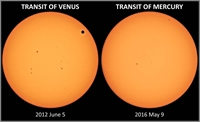
|
TRANSITS COMPARED
Transits of Venus (2012) and Mercury (2016) Compared. Transits of Venus are very rare (about one pair per century) but the large, black disk of Venus on the Sun is a sight to behold. Mercury transits are more common (about 13–14 per century) but also far less spectacular. Compare the last transit of Venus (2012) with the 2016 transit of Mercury in this picture. (Click to enlarge for better view.) Both planets are in upper right. (Other features are sunspots.) Photo Dates: 2012 June 5 & 2016 May 9. Locations: Fort Worth Texas & Gainesville, Florida. Photo Details: Tele Vue 76mm APO, f/6.3 with Tele Vue 4x Powermate giving effective f/25. Canon EOS 5D Mark II. Exposures: 180/sec, ISO 1600 & 1/180 sec., ISO 1000.
|
|
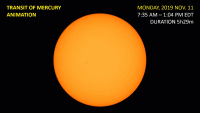
|
2019 TRANSIT OF MERCURY SIMULATION
Graphic Animation of the 2019 Transit of Mercury. Transits of Mercury across the face of the Sun are more common than those of Venus occurring about 13–14 times per century. However. they are not visible from all locations or may only be partially visible as was the case for Florida in 2009 when the Sun set before the transit was over. Nevertheless, the 2016 and 2019 transits of Mercury were entirely visible from Florida. Then none will be seen in Florida until 2049. This graphic animation simulates the crossing of Mercury in front of the Sun's disk during the 2019 transit. Click animation for a larger version. See photos below of the actual 2019 transit. Note: North is approx. to upper left, east down to left as it was a beginning of transit. (Animation by H.L. Cohen)
|
|
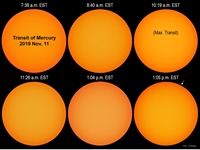
Composite
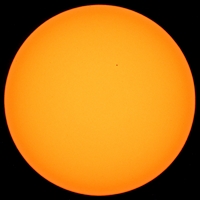
Single Frame: 11:26 a.m. EST
|
2019 TRANSIT OF MERCURY COMPOSITE
Photographs of the 2019 Transit of Mercury. Transits of Mercury occur more often than transits of Venus (13-14 per century) but are interesting and historically significant. The 2019 November 11 transit was visible during its entire 5h35m hour transit. However, the low altitude of the Sun at the beginning hid first contact for many observers (only 8 degrees high from Gainesville Florida). Although the disk of Mercury is small, its round, black shape (lower left) is easily distinguished from sunspots. However, the Sun was near a deep sunspot minimum and showed no sunspots. (About 75% of the days of the year up to the time of the transit showed a Sun without spots.)
Photo is a composite of six images from just after 2nd contact to just after 3rd contact. Photo Date: 2019 Nov. 11. Enlarge photo to see times. Location: Gainesville, Florida. Photo Details: Tele Vue NP 76mm APO, f/6.3 with Tele Vue 4x Powermate, giving effective f/25. Canon EOS 5D Mark II. Thousand Oaks Solar Filter (transmission 0.001%, optical density 5). Seeing became extremely bad as Sun rose. Exposures: 1/90, 1/125, 1/180, 1/180, 1/250, 1/250 sec. ISO equiv. 1000. (North is approx. to upper left, east to lower left as it was at beginning of transit.)
Below composite picture is a single frame taken at 11:26 a.m. EST (04:26 UT). Click to enlarge.
|
|
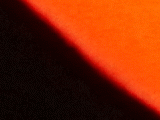
Animation (Repeats)
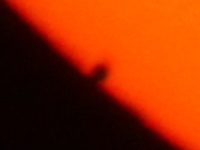
Single Frame
|
2019 TRANSIT OF MERCURY INGRESS
Ingress Made from Photographs of the 2019 Transit of Mercury. See above for details. Animation made from individual frames (cropped and enlarged) showing ingress from before first contact to after second contact. Seeing was poor. Can you see the "black drop" effect? Animation repeats.
Below animation is a single frame taken close to second contact at 07:37:43 a.m. EST (12:37:43 UT). Exp. f/125, 1/90s at ISO 1000. Thousand Oaks Solar Filter (transmission 0.001%, optical density 5).
(The next transit of Mercury visible from the USA is not until 2019 May 7!)
|
|
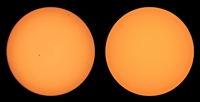
2016 (left) vs. 2019 (right)
(Click to Enlarge)
|
TRANSITS OF MERCURY COMPARED
Comparison of the 2016 and 2019 Transits.
The disk of Mercury appeared 20 percent larger for the 2016 transit (left) compared to the 2019 transit (right) and lasted two hours longer. However, Mercury passed much closer to the center of the Sun's disk during the 2019 transit. Also noticed conspicuous sunspots during the 2016 transit. However, the Sun was near sunspot minimum in 2019 and had no spots during the 2019 transit. In fact, the Sun had nearly 80 percent of the days in 2019 without spots breaking a space age record for a blank Sun. Both photos taken with same instrument and camera. See composite photo above for setup details.
|
|
|
BACK TO PICTURE CATEGORIES
or
RETURN TO HOME PAGE
Images © 2004–2023 H.L. Cohen
Email cohenhlc followed by @gmail.com
Last updated October 27, 2023 O
|